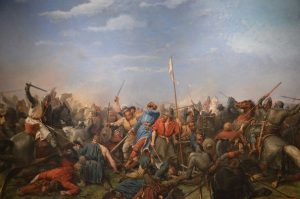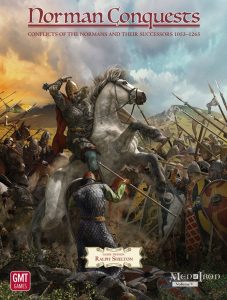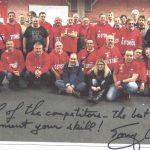#normanconquests Un wargame come “Norman Conquests” non si valuta solamente secondo mappa, meccaniche e ordine di battaglia ( anche se rimangono elementi da considerare), ma sull’impulso che può dare all’approfondimento del periodo. Spesso siamo costretti a provare in solitario le nostre scatole e l’apertura della confezione, la lettura delle brevi introduzioni storiche, il piazzamento delle unità sulla mappa costituiscono il primo vero approccio che ognuno di noi fa. Lo definirei quasi un rito, ma prima di incrociare le spade con l’amico avversario di turno é un passaggio obbligato che alimenta l’aspetto ‘solitario’ del nostro hobby. Spesso ci si ferma a questo primo livello che comunque può soddisfare i nostri desideri. Il passo successivo é quello di “giocare” il Wargame che ci restituisce un quadro completo sull’efficacia delle meccaniche messe in campo. Nella fattispecie non si può che elogiare “Norman Conquests” che risulta un prodotto ottimo alla luce di quanto precisato. Poi subentra la critica, sorgono i dubbi sulla mappa utilizzata, sulla presenza o meno di una tipologia di unità, ma passano in secondo piano rispetto a quello che può dare “Norman Conquests”. Le battaglie più o meno note, le brevi analisi storiche, la possibilità di modificare con house rule le condizioni di partenza o le condizioni di vittoria sono i punti di forza di questo buon Wargame di cui tutto si può dire meno che manchi la cura. É oltre un mese che questa scatola viene aperta e chiusa, studiata e analizzata e sarà così per i prossimi mesi. Certo l’alternativa a “conoscere” questo periodo sta nel leggere un buon libro, ma volete mettere la comprensione maggiore che può darvi ” Norman Conquests” che per argomento e cura non può mancare sullo scaffale dell’appassionato del Medioevo?
“According to Snorri Sturluson, before the battle a single man rode up alone to Harald Hardrada and Tostig. He gave no name, but spoke to Tostig, offering the return of his earldom if he would turn against Hardrada. Tostig asked what his brother Harold would be willing to give Hardrada for his trouble. The rider replied “Seven feet of English ground, as he is taller than other men” (implies that both Hardrada and his army will be killed and buried on English soil). Then he rode back to the Saxon host. Hardrada was impressed by the rider’s boldness, and asked Tostig who he was. Tostig replied that the rider was Harold Godwinson himself.[14] According to Henry of Huntingdon, Harold said “Six feet of ground or as much more as he needs, as he is taller than most men.”[citation needed]
The sudden appearance of the English army caught the Norwegians by surprise.[15] The English advance was then delayed by the need to pass through the choke-point presented by the bridge itself. The Anglo-Saxon Chronicle and the Chronicle of Henry of Huntingdon has it that one of the Norwegians (possibly armed with a Dane Axe) blocked the narrow crossing and single-handedly held up the entire English army. The story is that this Viking alone cut down up to 40 Englishmen and was defeated only when an English soldier floated under the bridge and thrust his spear through the planks in the bridge, mortally wounding the warrior.[16][17] His name was not preserved in the aftermath of this battle.
This delay had allowed the bulk of the Norse army to form a shieldwall to face the English attack. Harold’s army poured across the bridge, forming a line just short of the Norse army, locked shields and charged. The battle went far beyond the bridge itself, and although it raged for hours, the Norse army’s decision to leave their armour behind left them at a distinct disadvantage. Eventually, the Norse army began to fragment and fracture, allowing the English troops to force their way in and break up the Scandinavians’ shield wall. Completely outflanked, and with Hardrada killed with an arrow to his windpipe and Tostig slain, the Norwegian army disintegrated and was virtually annihilated.[18]
In the later stages of the battle, the Norwegians were reinforced by troops who had been guarding the ships at Riccall some 25 km away, led by Eystein Orre, Hardrada’s prospective son-in-law. Some of his men were said to have collapsed and died of exhaustion upon reaching the battlefield. The remainder were fully armed for battle. Their counter-attack, described in the Norwegian tradition as “Orre’s Storm”, briefly checked the English advance, but was soon overwhelmed and Orre was slain. The Norwegian army were routed. As given in the Chronicles, pursued by the English army, some of the fleeing Norsemen drowned whilst crossing rivers.[2]
So many died in an area so small that the field was said to have been still whitened with bleached bones 50 years after the battle.[19][20]”




